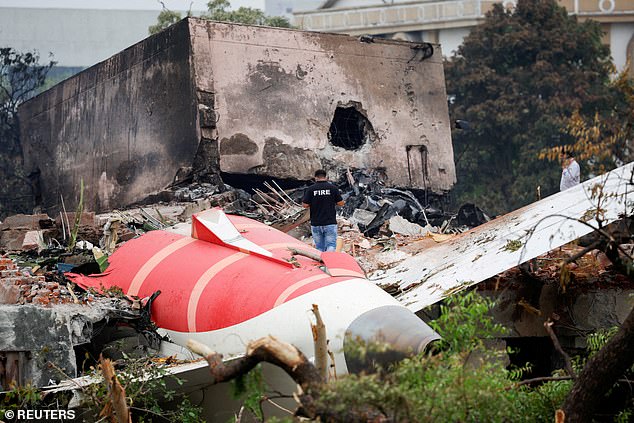Authorities investigating the deadly Air India 171 crash that killed at least 270 last week believe the doomed flight was using an emergency-power generator.
The preliminary finding has raised questions into whether the plane’s engines were working properly during take-off.
The Gatwick-bound Air India aircraft, a Boeing 787 Dreamliner, crashed on a medical college hostel soon after taking off from the western city of Ahmedabad last Thursday.
The Boeing was not much more than 400ft above ground when the two pilots experienced pilots onboard apparently lost power in both engines.
They then had 17 agonising seconds to wrestle with the controls before their state-of-the-art plane smashed into a medical college packed with doctors, sending a fireball soaring into the sky.
Experts from India’s Aircraft Accident Investigation Bureau are probing the crash with assistance from the UK, the US and officials from Boeing.
As investigations into the disaster are underway, one focus of the probe into the crash is whether the plane suffered a loss or reduction of thrust.

A fire officer stands next to the crashed Air India Boeing 787-8 Dreamliner aircraft, in Ahmedabad, India, June 13

Authorities investigating the deadly Air India 171 crash that killed at least 270 last week believe the doomed flight was using an emergency-power generator

The preliminary finding has raised questions into whether the plane’s engines were working properly during take-off
Emergency systems used in planes are known as ram air turbines. They are small propellers that drop from the bottom of the plane’s fuselage to operate as a backup generator.
These emergency systems usually deploy automatically in flight if both engines have failed or if hydraulic system pressures are low, and can deploy if cockpit instruments lose power.
Sources close to the investigation suggest that findings from the crash indicate that the plane’s flaps and other flight-control surfaces had been configured for takeoff, the Wall Street Journal reports.
Authorities investigating the tragic airplane crash are also studying the black boxes of the plane, and are also looking at whether it was overloaded.
Amit Singh, a former pilot and an aviation expert, said the recovery of the flight data and cockpit voice recorders, or black boxes, are crucial to piece together the sequence of events.
The cockpit voice recorder records pilots’ conversation, emergency alarms and any distress signal made before a crash. The plane’s digital flight data recorder stores information related to engine and control settings. Both devices are designed to survive a crash.
‘The data will reveal everything,’ Singh said, adding that the technical details could be corroborated by the cockpit voice recorder that would help investigators know of any communication between air traffic control and the pilots.

The Gatwick-bound Air India aircraft, a Boeing 787 Dreamliner, crashed on a medical college hostel soon after taking off from the western city of Ahmedabad last Thursday

Experts from India’s Aircraft Accident Investigation Bureau are probing the crash with assistance from the UK, the US and officials from Boeing

One focus of the probe into the crash is whether the plane suffered a loss or reduction of thrust
India’s aviation regulatory body has said pilots Sumeet Sabharwal and Clive Kunder made a mayday call before the crash.
Singh said the investigating authorities will scan CCTV footage of the nearby area and speak with witnesses to get to the root cause of the crash.
Additionally, Singh said, the investigators will also study the pilot training records, total load of the aircraft, thrust issues related to the plane’s engine, as well as its worthiness in terms of past performances and any previously reported issues.
The Indian government has set up a separate, high-level committee to examine the causes leading to the crash and formulate procedures to prevent and handle aircraft emergencies in the future.
The committee is expected to file a preliminary report within three months.
Authorities have also begun inspecting and carrying out additional maintenance and checks of Air India’s entire fleet of Boeing 787 Dreamliners to prevent any future incident. Air India has 33 Dreamliners in its fleet.
There were 53 British nationals on board Flight AI171 when it crashed into a residential area near the airport, as well as 159 Indian nationals, seven Portuguese citizens and a Canadian.
This is a breaking news story, more to follow.








